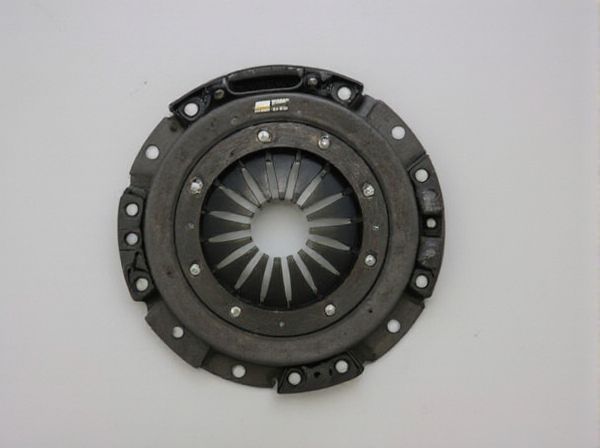
Photo illustration: Hydraulic Clutch vs Cable Clutch
A hydraulic clutch provides smoother operation and requires less pedal effort due to fluid pressure, offering enhanced control and durability compared to a cable clutch. Cable clutches are typically more straightforward and cost-effective but may require frequent adjustments and can feel less precise over time. Your choice depends on the desired driving experience and maintenance preferences.
Table of Comparison
| Feature | Hydraulic Clutch | Cable Clutch |
|---|---|---|
| Operation Mechanism | Fluid pressure via master and slave cylinders | Steel cable connecting clutch pedal to clutch |
| Effort Required | Lower pedal effort, smoother engagement | Higher pedal effort, less smooth engagement |
| Maintenance | Requires periodic brake fluid checks and bleeding | Needs cable lubrication and tension adjustment |
| Durability | Long-lasting but susceptible to leaks | Prone to cable stretch and wear |
| Cost | Higher initial cost, more complex system | Lower cost, simpler design |
| Responsiveness | Precise and consistent clutch engagement | Less consistent due to cable stretch |
Introduction to Hydraulic and Cable Clutches
Hydraulic clutches utilize fluid pressure to transfer force from the pedal to the clutch mechanism, providing smoother engagement and requiring less pedal effort compared to cable clutches. Cable clutches rely on a mechanical wire cable that directly connects the pedal to the clutch, often resulting in a more straightforward design but with potential for stretching and increased pedal effort over time. Both systems serve the essential function of disengaging the engine from the transmission to allow gear changes, but hydraulic clutches offer enhanced precision and reduced maintenance due to their sealed fluid system.
How Hydraulic Clutches Work
Hydraulic clutches operate by using fluid pressure to transfer force from the clutch pedal to the clutch mechanism, resulting in smoother and more consistent engagement compared to cable clutches. When the clutch pedal is pressed, hydraulic fluid is pushed through a master cylinder into a slave cylinder, which then actuates the clutch release bearing. This system reduces pedal effort and self-adjusts for clutch wear, enhancing durability and performance in vehicles.
How Cable Clutches Operate
Cable clutches operate by mechanically linking the clutch pedal to the clutch mechanism via a durable steel cable, which transfers the driver's foot pressure directly to disengage the clutch. This system relies on precise cable tension adjustments to maintain smooth and responsive clutch engagement and disengagement. Cable clutches are generally simpler, more cost-effective, and easier to maintain compared to hydraulic systems, but they can suffer from cable stretch and require periodic tuning to ensure optimal performance.
Key Differences Between Hydraulic and Cable Clutches
Hydraulic clutches use fluid pressure to engage and disengage the clutch, providing smoother and more consistent pedal feel compared to cable clutches, which rely on a mechanical wire that can stretch or wear over time. Hydraulic systems require less pedal effort and self-adjust for clutch wear, while cable clutches demand periodic manual adjustments to maintain proper performance. Maintenance complexity and initial cost are generally higher for hydraulic clutches, whereas cable clutches offer a simpler, more cost-effective design suitable for straightforward applications.
Performance Comparison: Smoothness and Response
Hydraulic clutches offer superior smoothness and quicker response due to their self-adjusting mechanism and consistent hydraulic pressure, resulting in precise and effortless engagement. Cable clutches may experience stiffness and require periodic adjustments, affecting smoothness and leading to less immediate response. The hydraulic system's ability to absorb vibrations enhances overall control, making it the preferred choice for high-performance and demanding driving conditions.
Maintenance Requirements and Costs
Hydraulic clutches generally require less frequent maintenance compared to cable clutches but involve higher initial repair costs due to complexity and the need for fluid replacement and system bleeding. Cable clutches demand regular lubrication and cable adjustments to prevent stretch and wear, resulting in lower immediate maintenance expenses but more frequent servicing. Choosing between the two depends on balancing higher upfront hydraulic system costs against ongoing cable maintenance efforts.
Durability and Reliability Factors
Hydraulic clutches offer superior durability due to sealed systems that prevent contamination and reduce wear, ensuring consistent performance over time. Cable clutches, while simpler and easier to repair, often suffer from cable stretch and fraying, leading to reduced reliability and more frequent adjustments. Overall, hydraulic clutches provide enhanced longevity and dependable operation under demanding driving conditions.
Customization and Adjustment Options
Hydraulic clutches offer precise self-adjustment through fluid pressure, minimizing the need for manual tuning and providing consistent pedal feel over time. Cable clutches require frequent manual adjustments to maintain optimal cable tension, which can be customized easily but may lead to inconsistent performance if neglected. Customization options for cable clutches include adjustable cable length and tensioners, while hydraulic systems rely on component selection like master and slave cylinder sizes for performance tuning.
Suitability for Different Riding Styles
Hydraulic clutches offer smoother, more precise control, making them ideal for aggressive riding styles such as racing or off-roading where quick, consistent clutch engagement is crucial. Cable clutches provide a more mechanical feel with straightforward maintenance, suiting casual riders and commuters who prefer a simpler, cost-effective system. The choice between hydraulic and cable clutches depends on the rider's preference for responsiveness and the type of terrain or riding conditions encountered.
Choosing the Right Clutch System for Your Needs
Hydraulic clutches offer smoother engagement and require less pedal effort due to their fluid pressure mechanism, making them ideal for performance and heavy-duty vehicles. Cable clutches provide a more straightforward, cost-effective solution with easier maintenance, suited for everyday commuting and budget-focused drivers. Selecting the right system depends on driving style, maintenance preferences, and vehicle type, with hydraulic clutches favored for precision and cable clutches for simplicity.
 caratoz.com
caratoz.com